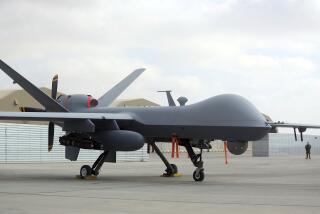A closer look at drones
Reports that the United States is establishing bases for drone aircraft in the Horn of Africa and the Arabian Peninsula are the latest example of a transformation in the war on terrorism that poses serious questions about overreach and accountability. According to the Washington Post, a “constellation” of bases would allow the targeting of Al Qaeda affiliates and other terrorists in Yemen and Somalia, new battlegrounds in the conflict with Islamic militants. Though some of the drones are supposed to be unarmed, the overall effort is designed for counter-terrorism, a term that encompasses both the gathering of intelligence and targeted killings. Bases are being established or have been established in Ethiopia, the Seychelles and Djibouti.
Clearly the CIA and the Pentagon regard the campaign of assassination by air as a success. And in some ways, drone warfare is preferable to the alternative. For example, attacks by drones are less likely to result in the death of unintended victims than strikes by, say, fighter jets. That’s not to say that there hasn’t been collateral damage, but if one accepts the basic principle that assassination of enemy operatives is legitimate and that some innocent lives will be lost in the process, the use of unmanned aircraft doesn’t change the moral calculus.
But are these targeted killings in fact legitimate? One worrisome aspect is the geographical reach of the strategy. We’re at war in Afghanistan (a conflict that has spilled over into Pakistan), but do we also have the right to kill people we think may pose a threat in Somalia or Yemen? And if we can do it in Somalia and Yemen, can we also do it in London or Los Angeles? Would we think it was acceptable if Russia gunned down a Chechen terrorist on the streets of New York? Granted, the battlefield in the war against terrorism transcends national borders, but surely there must be some limit? Instead, Congress is moving to expand the theater of operations. A defense bill approved in May by the House of Representatives authorizes force directed against “Al Qaeda, the Taliban, and associated forces,” but doesn’t include any geographical limitations whatsoever.
We’re also concerned about the process by which the military and the CIA determine who belongs on a target list. The United States should not be aiming its missiles at everyone who associates with Al Qaeda and similar groups, or at mere propagandists. (The U.S. government now considers Anwar Awlaki, the American citizen thought to be on a target list, an operative as well as a spokesman for Al Qaeda in the Arabian Peninsula.) Decisions about targeted killings should be reviewed at the highest levels of the administration and monitored closely by Congress.
Targeted killings raise serious moral and legal questions, but the Obama administration seems determined to expand their use as the United States withdraws forces from Afghanistan. If the policy is to be pursued, it should be subject to more stringent oversight. That includes a greater effort to avoid civilian casualties — an effort the administration insists it makes — and a decision to limit aerial assassination to terrorist leaders who are actually planning attacks on the United States. The establishment of new drone bases accentuates the importance of such controls.
More to Read
A cure for the common opinion
Get thought-provoking perspectives with our weekly newsletter.
You may occasionally receive promotional content from the Los Angeles Times.










